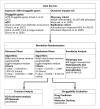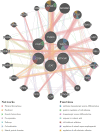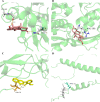Identification of Potential Drug Targets for Myopia Through Mendelian Randomization
- PMID: 39110588
- PMCID: PMC11314700
- DOI: 10.1167/iovs.65.10.13
Identification of Potential Drug Targets for Myopia Through Mendelian Randomization
Abstract
Purpose: The purpose of this study was to identify potential drug targets for myopia and explore underlying mechanisms.
Methods: Mendelian randomization (MR) was implemented to assess the effect of 2684 pharmacologically targetable genes in the blood and retina on the risk of myopia from a genomewide association study (GWAS) for age-at-onset of spectacle wearing-inferred mean spherical equivalent (MSE; discovery cohort, N = 287,448, European), which was further validated in a GWAS for autorefraction-measured MSE (replication cohort, N = 95,619, European). The reliability of the identified significant potential targets was strengthened by colocalization analysis. Additionally, enrichment analysis, protein-protein interaction network, and molecular docking were performed to explore the functional roles and the druggability of these targets.
Results: This systematic drug target identification has unveiled 6 putative genetically causal targets for myopia-CD34, CD55, Wnt3, LCAT, BTN3A1, and TSSK6-each backed by colocalization evidence in adult blood eQTL datasets. Functional analysis found that dopaminergic neuron differentiation, cell adhesion, Wnt signaling pathway, and plasma lipoprotein-associated pathways may be involved in myopia pathogenesis. Finally, drug prediction and molecular docking corroborated the pharmacological value of these targets with LCAT demonstrating the strongest binding affinity.
Conclusions: Our study not only opens new avenues for the development of therapeutic interventions for myopia but may also help to understand the underlying mechanisms of myopia.
Conflict of interest statement
Disclosure:
Figures






Similar articles
-
Identification of drug targets for Sjögren's syndrome: multi-omics Mendelian randomization and colocalization analyses.Front Immunol. 2024 Jun 12;15:1419363. doi: 10.3389/fimmu.2024.1419363. eCollection 2024. Front Immunol. 2024. PMID: 38933282 Free PMC article.
-
Identifying potential drug targets for seborrheic keratosis through druggable genome-wide Mendelian randomization and colocalization analysis.Arch Dermatol Res. 2025 Feb 7;317(1):359. doi: 10.1007/s00403-025-03875-y. Arch Dermatol Res. 2025. PMID: 39918628
-
Mendelian randomization and colocalization analysis reveal novel drug targets for myasthenia gravis.Hum Genomics. 2024 Apr 24;18(1):43. doi: 10.1186/s40246-024-00607-7. Hum Genomics. 2024. PMID: 38659056 Free PMC article.
-
Association of sleep traits with myopia in children and adolescents: A meta-analysis and Mendelian randomization study.Prev Med. 2024 Mar;180:107893. doi: 10.1016/j.ypmed.2024.107893. Epub 2024 Feb 9. Prev Med. 2024. PMID: 38342383 Review.
-
Target Discovery for Drug Development Using Mendelian Randomization.Methods Mol Biol. 2022;2547:1-20. doi: 10.1007/978-1-0716-2573-6_1. Methods Mol Biol. 2022. PMID: 36068458 Review.
Cited by
-
Associations Between Myopia and Brain Volumes: An Observational and Genetic Analysis.Invest Ophthalmol Vis Sci. 2025 Jun 2;66(6):57. doi: 10.1167/iovs.66.6.57. Invest Ophthalmol Vis Sci. 2025. PMID: 40530922 Free PMC article.
-
DNA methylation biomarkers and myopia: a multi-omics study integrating GWAS, mQTL and eQTL data.Clin Epigenetics. 2024 Nov 13;16(1):157. doi: 10.1186/s13148-024-01772-1. Clin Epigenetics. 2024. PMID: 39538342 Free PMC article.
-
Ferroptosis in ocular diseases: mechanisms, crosstalk with other cell death pathways, and therapeutic prospects.Front Med (Lausanne). 2025 Jul 8;12:1608975. doi: 10.3389/fmed.2025.1608975. eCollection 2025. Front Med (Lausanne). 2025. PMID: 40697914 Free PMC article. Review.
References
-
- Dunphy EB. The biology of myopia. N Engl J Med. 1970; 283(15): 796–800. - PubMed
-
- Morgan IG, French AN, Ashby RS, et al. .. The epidemics of myopia: aetiology and prevention. Prog Retin Eye Res. 2018; 62: 134–149. - PubMed
-
- Naidoo KS, Fricke TR, Frick KD, et al. .. Potential lost productivity resulting from the global burden of myopia: systematic review, meta-analysis, and modeling. Ophthalmology. 2019; 126(3): 338–346. - PubMed
MeSH terms
LinkOut - more resources
Full Text Sources
Miscellaneous

